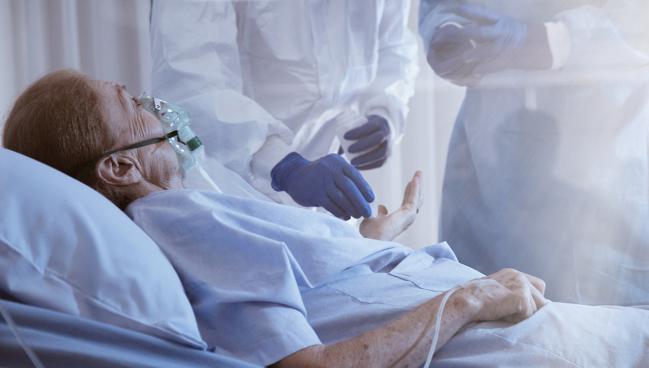Statewide Data Spotlight Lasting Impact of Pandemic’s PCI Shortfall in 2020
Fewer PCIs and higher mortality: a new snapshot captures three pandemic waves and renews talk of COVID’s collateral damage.

A comprehensive analysis of PCI volumes in the state of Michigan during the COVID-19 pandemic’s first year echoes the patterns reported over shorter periods for other regions around the world, offering the added insight that at least for primary PCI patients, the risk of a poor outcome remained elevated even as volumes started to return to normal.
The increased risk of death among people undergoing PCI in Michigan from March through December 2020, as compared with the same months 1 year prior, is only partially explained by the higher risks faced by COVID-positive patients, say Lorenzo Azzalini, MD (University of Washington, Seattle), and colleagues, who reported their findings this week in PLOS ONE.
To TCTMD, Azzalini pointed to the “collateral-damage” hypothesis that he and others have explored in the past, linking medical care avoidance to deteriorating illness and worse outcomes. This latest study, he said, cannot rule out the possibility that patients across the spectrum of CAD were presenting later in the course of their disease and as a result underwent higher-risk procedures.
“You might speculate that some patients who were supposed to get a cath or a PCI at a certain stage over their disease process, then for some reason they did not get treated when they were supposed to be treated, [that] in some cases that led to a downward spiral in their clinical condition,” he said. In turn, Azzalini continued, “the outcomes were poor and dismal for some of these patients.”
Missing STEMI Fallout Continued
As previously reported by TCTMD, the “missing STEMI” phenomenon of the early COVID-19 pandemic mirrored a plummet in PCI procedures around the world, including Europe, New York, Korea, with the European Society of Cardiology later documenting a worldwide drop in STEMI admissions during the first few months of 2020.
For the analysis reported this week, Azzalini and colleagues, with senior author Hitinder Gurm, MBBS (University of Michigan, Ann Arbor), sought to track statewide PCI volumes and outcomes beyond the earlier windows reported by prior studies, looking instead over a 10-month period in 2020 so as to capture both the second and third waves of the pandemic.
During this period, the researchers say, overall PCI rates declined by 15.2% at the 48 Michigan hospitals participating in the Blue Cross Blue Shield of Michigan Cardiovascular Consortium (BMC2) registry (representing all but one cath-equipped hospital in the state), as compared with the same hospitals during the prepandemic period. That’s despite the fact that both patient groups had similar clinical and procedural features, they note. The decline was particularly pronounced during the earlier months (February to May) and in people suffering from unstable angina and non-ST-elevation ACS.
Mortality, notably, was higher throughout the pandemic months for patients requiring primary PCI: additional analyses confirmed that patients testing positive for COVID-19 had higher mortality during PCI (adjusted odds ratio 5.69, 95% CI 2.54–12.74) but active infections did not fully explain this increased risk, the authors write. Moreover, door-to-balloon times were very similar between the prepandemic and pandemic periods, suggesting that system delays were likely not a major factor in the worse outcomes seen.
Azzalini and colleagues conclude that, based on these observations, the collateral-damage hypothesis can only be considered “purely speculative,” but it will be important to keep in mind if new variants lead to new lockdowns or prompt patients to delay medical care in the future.
Azzalini remains open to the notion that later presentation for ACS may have been a factor in some cases, or that delays in more-routine cardiovascular care, for coronary disease but also valve disease or heart failure management, may have led to scenarios in which patients ultimately undergoing PCI were doing so with more complex cardiovascular needs.
“Maybe a PCI that would have been more straightforward, let's say, in March of 2020 but instead was performed in September or November 2020 and the patient then required mechanical circulatory support . . . or developed a preprocedure complication, or developed something like nosocomial pneumonia afterwards—these are things that are very difficult to track and attribute to the actual COVID-19 disruptions that might have played a role.”
Confirming findings of other analyses, including those of the NACMI registry, Michigan patients testing positive versus negative for COVID-19 in this series were more likely to be Black (24.7% vs 11.5%), have diabetes (51.6% vs 41.9%), present with STEMI (35.5% vs 12.8%), have cardiac arrest (4.3% vs 0.9%) or multivessel disease (55.9% vs 46.5%), and need mechanical circulatory support (8.6% vs 3.9%).
This speaks, Azzalini said, to the interplay of COVID-19 and social determinants of health in worsening cardiovascular outcomes and is “yet another confirmation that COVID-19 disproportionately impacted minorities.”
Shelley Wood was the Editor-in-Chief of TCTMD and the Editorial Director at the Cardiovascular Research Foundation (CRF) from October 2015…
Read Full BioSources
Azzalini L, Seth M, Sukul D. Trends and outcomes of percutaneous coronary intervention during the COVID-19 pandemic in Michigan. PLoS ONE. 2022;17(9): e0273638.
Disclosures
- Azzalini reports no relevant conflicts of interest.





Comments